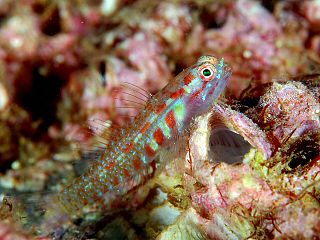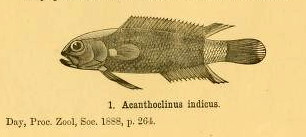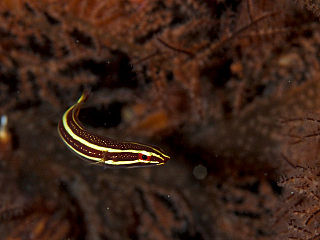
Eleotridae is a family of fish commonly known as sleeper gobies, with about 34 genera and 180 species. Most species are found in the tropical Indo-Pacific region, but there are also species in subtropical and temperate regions, warmer parts of the Americas and near the Atlantic coast in Africa. While many eleotrids pass through a planktonic stage in the sea and some spend their entire lives in the sea; as adults, the majority live in freshwater streams and brackish water. One of its genera, Caecieleotris, is troglobitic. They are especially important as predators in the freshwater stream ecosystems on oceanic islands such as New Zealand and Hawaii that otherwise lack the predatory fish families typical of nearby continents, such as catfish. Anatomically, they are similar to the gobies (Gobiidae), though unlike the majority of gobies, they do not have a pelvic sucker.

Eviota is a genus of fish in the family Gobiidae, commonly as dwarfgobies found in the Indo-Pacific region, where it is distributed from Japan to Australia and from Africa to Pitcairn Island. Species are mainly associated with coral reefs. Many of these fish are short-lived, with life cycles as brief as 3.5 weeks in the tropics. Some species are hermaphrodites and some representatives live symbiotically among the tentacles of the mushroom coral.

Entomacrodus is a genus of combtooth blennies.

Acanthoplesiops is a genus of reef-dwelling fishes belonging to the family Plesiopidae. All species are very small, with the largest specimen recorded only reaching 27 mm standard length. They have several features which distinguish them from other plesiopids, the most obvious of which is the presence of one or two spines on the operculum.
The arrow wriggler, also known as Tyson's wriggler, is a species of fish in the monotypic genus Tyson of the Xenisthmidae (wriggler) family, which is regarded as a synonymous with the Eleotridae, Tyson's wriggler was discovered in 1983. It moves by wriggling, like other wrigglers. The genus is named for American ichthyologist Tyson R. Roberts; the specific epithet belos is Greek for "arrow". The arrow wriggler has been recorded from scattered localities in the West Pacific Ocean including Flores in Indonesia, the Trobriand Islands, the Great Barrier Reef, the Solomon Islands, Vanuatu and Fiji. It is found at depths ranging from is 10 to 30 metres.
Dorothea's wriggler, Allomicrodesmus dorotheae, is a species of fish in the monotypic genus Allomicrodesmus which is regarded by some authorities as being in the family Xenisthmidae, the wriggler family, but in the 5th edition of Fishes of the World this is treated as a synonym of the family Eleotridae, sleeper gobies. It is 5 cm (2.0 in) in length. It is known from just two specimens, one from the Great Barrier Reef and the other from the Marshall Islands. It has been collected from a depth of around 10 m (33 ft) in a channel in a reef. The specific name honours Dorothea Bowers Schultz, the wife of Leonard Peter Schultz, who illustrated the monograph in which this species is described, although not this species.

Xenisthmus is the most well-known genus in the family Xenisthmidae,which is regarded as a synonymous with the Eleotridae, a part of Gobiiformes. These small to very small fish are known as wrigglers, and live in reefs and among rubble in the Indo-Pacific.
Xenisthmus balius is a species of fish in the Xenisthmidae (wriggler) family, which is regarded as a synonymous with the Eleotridae,. It is found in the Persian Gulf.
Rotuma lewisi, or Lewis's wriggler, is a species of fish in the family Xenisthmidae, which is regarded as a synonymous with the Eleotridae. Rotuma is a monotypic genus. The generic name refers to the volcanic island of Rotuma, north of Fiji while the specific name honours Anthony D. Lewis, a Fisheries Officer of the Government of Fiji who supported Springer's field work in Fiji. It has been recorded from Fiji, Tonga, the Santa Cruz Islands, the Comoros Islands, and the Chesterfield Islands.
Xenisthmus africanus, also known as the flathead wriggler or African wriggler, is a species of fish in the Xenisthmidae (wriggler) family, which is regarded as a synonymous with the Eleotridae,. It is found in the Indian Ocean, ranging from the coast of east Africa and to the islands in the western Indian Ocean. It has a flatter head than most other wrigglers.
Xenisthmus chi is a species of fish in the wriggler family, Xenisthmidae, which is regarded as a synonymous with the Eleotridae,. Japan wrigglers are tiny and clear. Before Paedocypris progenetica and the dwarf goby were discovered, the Japan wriggler was the smallest known fish.

Lepadichthys is a genus of clingfishes native to the Indian and Pacific Oceans.
Paraxenisthmus springeri is a species of fish in the genus Paraxenisthmus of the Xenisthmidae (wriggler) family, which is regarded as a synonymous with the Eleotridae, from the West Pacific. Its specific name honours the American ichthyologist Victor G. Springer of the U.S. National Museum for his contributions to fish systematics.
Paraxenisthmus is a genus of goby from the western Pacific. They were classified as being in the family Xenisthmidae but this family is regarded as a synonym of the Eleotridae.
Xenisthmus eirospilus, the spotted wriggler, is a species of fish in the wriggler family, Xenisthmidae, which is regarded as a synonymous with the Eleotridae,. It is distributed in the western Pacific from Middleton Reef and Ashmore Reef off Australia, West Papua, Indonesia, to Rotuma and Tonga. Its habitat is sand patches among reefs and rubble, as well as in shallow surge areas.
Xenisthmus semicinctus, the halfbelt wriggler, is a species of fish in the wriggler family, Xenisthmidae, which is regarded as a synonymous with the Eleotridae,.
Hetereleotris is a genus of gobies native to the western Indian Ocean and the western Pacific Ocean.

Trimma is a genus of fish in the family Gobiidae native to the Indian and Pacific Ocean. Together with members of the genus Eviota, they are known commonly as pygmygobies or dwarfgobies.
Gymnoxenisthmus tigrellus, is a species of family Xenisthmidae, regarded as a synonym of the Eleotridae. This species is endemic to Red Sea occurring near an unnamed island in Farasan Archipelago, Red Sea, Saudi Arabia where it is found on a narrow reef flat at 8 metres (26 ft) depth. the area consisting of a sandy slope with patches of corals and near a rock face of 3 metres (9.8 ft) in height which had small caves and rock shelters. This species is the only known member of its genus.
Paraxenisthmus cerberusi is a species of fish in the genus Paraxenisthmus of the Xenisthmidae (wriggler) family, which is regarded as a synonymous with the Eleotridae, from Palau and Fiji in the West Pacific. Its specific name refers to Cerberus, the three-headed dog which guards the entrance to Hades in Greek mythology, given to this species because of its relatively large number of teeth and in reference to the black juveniles and the red and black adults, the colours of which are associated with Hell in Christianity. This small fish was found in a drop-off which had caves and ledges with shelves and slopes covered in silt and sand. The area had growths of hydroids, sea fans, a range of hard corals and some Halimeda.






